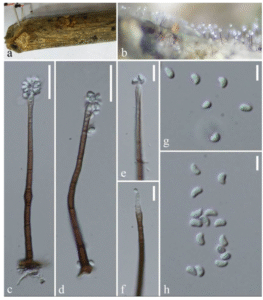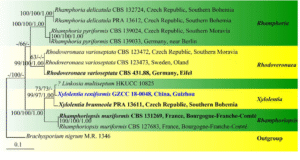Xylolentia reniformis C.G. Lin, K.D. Hyde & Jian K. Liu, sp. nov.
Index Fungorum number: IF 556253; MycoBank number: MB 556253; Facesoffungi number: FoF 05995; Fig. 65
Etymology: In reference to the reniform conidia.
Holotype: MFLU 19-0210.
Saprobic on decaying wood. Sexual morph: Undetermined. Asexual morph: Colonies effuse on the natural substrate, scattered, hairy, dark brown. Mycelium partly superficial and partly immersed in the substratum. Conidiophores macronematous, mononematous, scattered, erect, simple, straight or slightly flexuous, smooth, thick-walled, septate, cylindrical, dark brown at the base, paler towards the apex, 65–160 µm long, 3–9.5 µm thick at the base, slightly tapering towards the conidiogenous cells just below the apex then swelling again. Conidiogenous cells polyblastic, integrated, sympodial, terminal, clavate, subhyaline to pale brown, 14–40 µm long, 3–4.5 µm thick in the broadest part. Conidia aggregated in slimy masses, acropleurogenous, simple, smooth, aseptate, reniform, hyaline, 3.2–4.6 µm long, 1.8–3.0 µm thick in the broadest part.
Culture characteristics: Conidia germinating on WA (water agar) within 48 h. Colonies on PDA circular, appearing waxy-mucoid, white-brown, reaching a diam of 7.5–9 mm in 30 days at 28 °C.
Material examined: CHINA, Guizhou Province, Qiannan Buyi Miao Autonomous Prefecture, Dushan County, Guizhou Zilinshan National Forest Park (Shengou district), on decaying wood, 6 July 2018, C.G. Lin, DS 1–37 (MFLU 19-0210, holotype; HKAS 105134, isotype), ex-type living cultures GZCC 1-–0048.
GenBank numbers: ITS: MK547646; LSU: MK547648.
Notes: The phylogenetic result based on a combined LSU and ITS sequence dataset indicated that Xylolentia reniformis is closest to Linkosia multiseptum (HKUCC 10825) and X. brunneola (PRA 13,611) (Fig. 66). Shenoy et al. (2016) showed Linkosia is polyphyletic and phylogenetically located in three different lineages within the Sordariomycetes, viz., Chaetosphaeriales, Hypocreales and Sordariomycetes incertae sedis. L. multiseptum has brown and distoseptate conidia and conidiophores reduced to conidiogenous cells. Réblová and Štěpánek (2018) showed the phylogenetic placement of L. multiseptum in the Rhamphoriaceae was unexpected based on its morphology. Morphologically, X. reniformis fits well with the concept of Xylolentia (Réblová and Štěpánek 2018). X. reniformis differs from L. multiseptum and X. brunneola by its conidia being aseptate, reniform and hyaline and longer conidiophores. The conidia of X. brunneola are ellipsoid to subglobose to obovoid, aseptate, straight, hyaline becoming pale brown. Due to the unsolved taxonomic placement of Linkosia, as well as the morphological assignment, we hereby identify our new collection as a species of Xylolentia even though it is phylogenetically closer to L. multiseptum (Fig. 66).

Fig. 65 Xylolentia reniformis (MFLU 19-0210, holotype). a Host material. b Conidiophores on the host surface. c, d Conidiophores, conidiogenous cells with conidia. e, f Conidiogenous cells. g, h Conidia. Scale bars: c, d = 20 μm, e, f = 10 μm, g, h = 5 μm

Fig. 66 Phylogenetic tree generated from ML analysis based on combined LSU and ITS sequence data for Rhamphoriaceae. Bootstrap support values (MP and ML) ≥ 50% and Bayesian posterior probabilities ≥ 0.95 are indicated above or below the nodes. Ex-type strains are in bold, the new isolate is in blue. The tree is rooted with Brachysporium nigrum (M.R. 1346)
